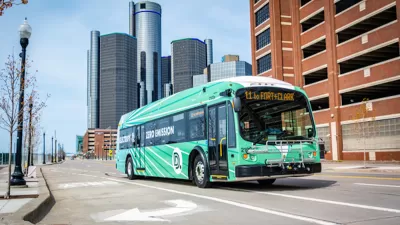Would the Motor City have produced Motown without pianos in every living room?

"The history of American music was literally shaped by the single family housing character of Detroit," writes Aaron M. Renn.
David Maraniss's new book, Once in a Great City: A Detroit Story, points to the signs of decline as early as 1963 when the city was in its economic and artistic heyday. (As Adam Gopnik keenly describes it in The New Yorker, "Humpty Dumpty's most poignant moment [was] just before he toppled over.") But here Renn zeroes in on a housing lesson that runs counterintuitive to today's thinking about urban planning. The single-family homes of Detroit allowed working- and middle-class families to accommodate pianos; and the piano was the springboard for the great musical energy that would become known around the world as Motown.
Renn cautions against making too much of the connection. "As Gordy was founding Motown, Jane Jacobs was pointing out the trouble with Detroit’s 'gray belts' of single families that were already being abandoned." Certainly, Detroit was not the only city of its time with a predominance of single-family homes. Gopnik points to in-group competition, as studied by art historian E.H. Gombrich, as a likely cause of such renaissance, likening it more to 13th-century Florence than other Rust Belt cities. "If Detroit got it worse, it was partly because it had it better," Gopnik writes.
Renn's point is that cities would do well to think creatively about their unique sets of constraints and circumstances. "What this suggests is that cities shouldn’t despair too much about their existing built form, even if in many cases they are struggling with it. The question might be, what does that form enable that you can’t get elsewhere?"
FULL STORY: How Urban Planning Made Motown Records Possible

Alabama: Trump Terminates Settlements for Black Communities Harmed By Raw Sewage
Trump deemed the landmark civil rights agreement “illegal DEI and environmental justice policy.”

Study: Maui’s Plan to Convert Vacation Rentals to Long-Term Housing Could Cause Nearly $1 Billion Economic Loss
The plan would reduce visitor accommodation by 25% resulting in 1,900 jobs lost.

Planetizen Federal Action Tracker
A weekly monitor of how Trump’s orders and actions are impacting planners and planning in America.

Waymo Gets Permission to Map SF’s Market Street
If allowed to operate on the traffic-restricted street, Waymo’s autonomous taxis would have a leg up over ride-hailing competitors — and counter the city’s efforts to grow bike and pedestrian on the thoroughfare.

Parklet Symposium Highlights the Success of Shared Spaces
Parklets got a boost during the Covid-19 pandemic, when the concept was translated to outdoor dining programs that offered restaurants a lifeline during the shutdown.

Federal Homelessness Agency Places Entire Staff on Leave
The U.S. Interagency Council on Homelessness is the only federal agency dedicated to preventing and ending homelessness.
Urban Design for Planners 1: Software Tools
This six-course series explores essential urban design concepts using open source software and equips planners with the tools they need to participate fully in the urban design process.
Planning for Universal Design
Learn the tools for implementing Universal Design in planning regulations.
Caltrans
Smith Gee Studio
Institute for Housing and Urban Development Studies (IHS)
City of Grandview
Harvard GSD Executive Education
Toledo-Lucas County Plan Commissions
Salt Lake City
NYU Wagner Graduate School of Public Service





























